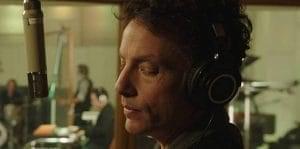
Smartly, Jakob Dylan and company stay away from trying to recreate some of the most complex and iconic hits like Good Vibrations. What could they add to that? Instead, they mostly focus on the slightly lesser known songs of the period. Their versions switch nearly seamlessly between them recording it in a studio and live performances. I have no idea how the joins were done — some kind of editing voodoo — but the transitions are magical.
At first, I was confused about Jakob Dylan’s ever-present role in the film. He interviews the principals and is the main player on all the new versions of the songs. Was this just a new album vanity project for him? That doubt quickly melted away when I saw what he had to offer. He’s always a charismatic presence on camera, and a gifted musician. Moreover, he seems genuinely curious about history and isn’t afraid to be seen as a student among the masters of the era.
“Music is the essence here, and you just can’t help but get carried away…”
Another genius behind the film is Andrew Slater. He directed, produced, and co-wrote the movie, and expertly chose to focus on a singular narrative that carries us through without being sidetracked by all the fascinating anecdotes of the time. It helped that he was formerly the CEO of Capitol Music, so had relationships with some of the featured artists. The rights clearances alone would have doomed a film from nearly anyone else. Slater was able to achieve a critical mass of notable artists, and show a work in progress to others to show just how serious a doc this was.
The reality is that no amount of words can truly give you the experience of this film. Music is the essence here, and you just can’t help but get carried away in the songs. Beyond that, the personalities involved are irresistible, helped of course by a half-century of friendships, love, backstabbing, affairs, and intrigue. Then when you layer on the modern artists and their takes, you just get something we’ve never really seen before.
Ultimately these bands broke up, sometimes re-forming into new collectives — Stephen Stills from Buffalo Springfield, David Crosby from the Byrds, and Graham Nash from the Hollies came together to form Crosby, Stills & Nash (later to add Neil Young, also from Buffalo Springfield). The film traces the end of that era to Young leaving Buffalo Springfield. The era of the individual had begun, and the psychedelic scene would cause rock music to mutate again. But the LA scene in 1964-1967 was still something magical. The counterculture was starting, women’s rights and civil rights were entering the public consciousness, and folk was morphing into rock.
Many of these folks won’t be around much longer. I have a feeling Echo in the Canyon will be watched for decades into the future as the essential document of a very specific time and place that changed music forever.

Echo In The Canyon (2018) Directed by Andrew Slater. Written by Eric Barrett, Andrew Slater. Echo In The Canyon screened at the 2019 Santa Barbara International Film Festival and the 2019 San Francisco International Film Festival.
Rating: 10/10


Andy melds gracefully with the work team of the documentary rippling its power to cause change beyond magical entertaining moments across the audience. He grasps this and delivers this in his breathtaking writing.
Who’s mid century modern house was it shot in? Perfect location. Helped nail the concept to place. Lived in Laurel Canyon in 1974. Was cool then too. Glad they captured it so well. Bravo.
I saw a version of this and it was horrible! They had to get a professional movie doctor in to fix it. Smart move by the director.
I’ve been waiting years for this. A magical time when the stars converged (no pun intended)
Wow- I can’t wait to see it! Sounds magical!
I’ve been waiting on this film for quite sometime… excited to see/ hear what Jacob has done ????
Excellent! When and where can I see this documentary?
Hitchcock cinema Santa Barbara. Indeed Andy just seems part of the documentary team so well he grasps the gist of it. I watched it twice last Saturday.